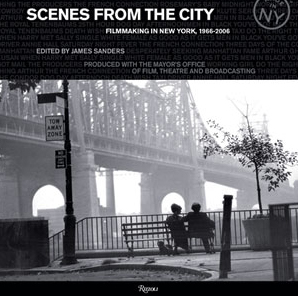(Rizzoli International Publications, 288 pages, $49.95)
By James Sanders
 Although filmmaking in this country had its start in New York at the turn of the last century, once the industry moved to Los Angeles, it pretty much steered clear of the city until 1966 when John V. Lindsay established the Mayor’s Office of Film, Theatre and Broadcasting. Hollywood knew that New York’s convoluted permit system and sometimes-uncooperative police could derail a big-budget movie in an afternoon. The city as seen in most Hollywood movies before 1966 was often no more real than the Empire State Building in King Kong. How things have changed.
Although filmmaking in this country had its start in New York at the turn of the last century, once the industry moved to Los Angeles, it pretty much steered clear of the city until 1966 when John V. Lindsay established the Mayor’s Office of Film, Theatre and Broadcasting. Hollywood knew that New York’s convoluted permit system and sometimes-uncooperative police could derail a big-budget movie in an afternoon. The city as seen in most Hollywood movies before 1966 was often no more real than the Empire State Building in King Kong. How things have changed.
James Sanders, a New York writer and architect, concentrates mainly on the explosion in film production that the Mayor’s Office directly facilitated and which continues to this day. A short introductory chapter outlines New York location shooting before 1966, an era with a rich but diffuse tradition of documentarians, avant-gardists, independents and wayward studio outings like Jules Dassin’s The Naked City in 1948.
The Mayor’s Office, which produced this book to celebrate its 40th anniversary, clearly aided in the development of a distinctly New York cinematic sensibility. Directors like Sidney Lumet, Woody Allen, Martin Scorsese, Spike Lee, and Jim Jarmusch might never have developed their hometown worldviews without the filmmaker-friendly civic attitude.
Sanders’ vividly illustrated account is filled with shots from famous New York movies of the last 40 years, and over 200 splendid production stills showing the challenges of shoehorning the massive apparatus of film production into a crowded modern city. The book also includes a perceptive interview with Scorsese along with comments and anecdotes throughout from Nora Ephron, Allen and other diehard New Yorkers. The story is divided not just into eras, but neighborhoods and types of locations—rooftops, the subway, Central Park—thus demonstrating that there are as many faces to this great city as there are filmmakers to capture it.
Review written by John Patterson.